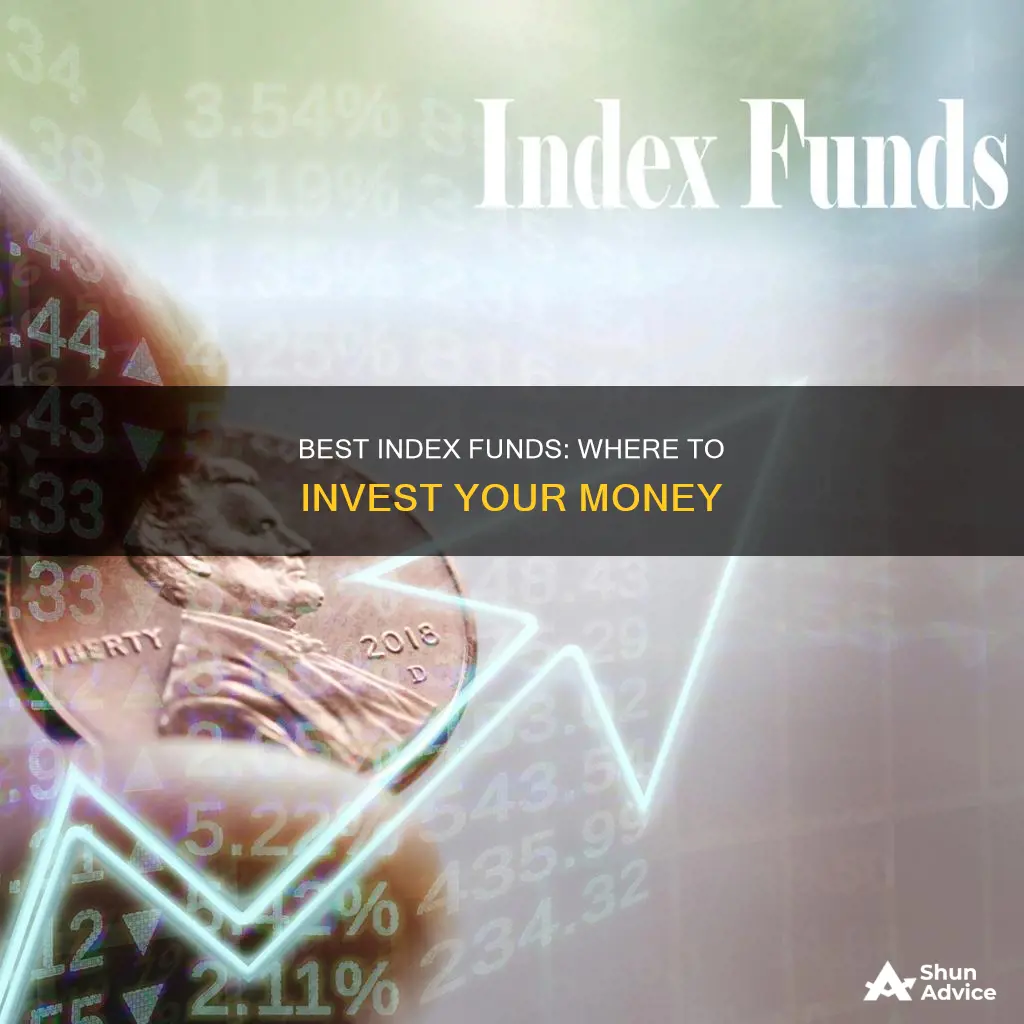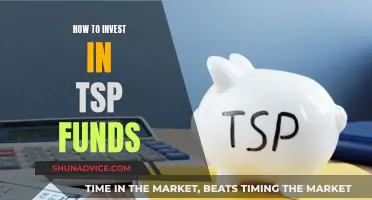
Index funds are a type of mutual fund or exchange-traded fund (ETF) that tracks the performance of a market index, such as the S&P 500 or the Nasdaq-100. They are a passive investment strategy, meaning they aim to replicate the performance of a particular index as closely as possible. Index funds are popular because they offer investors broad diversification, low costs, and relatively low risk. When choosing an index fund to invest in, it's important to consider factors such as the fund's expense ratio, performance track record, and the level of diversification it offers. Here are some of the best index funds to invest in as of October 2024:
- Fidelity ZERO Large Cap Index
- Vanguard S&P 500 ETF
- SPDR S&P 500 ETF Trust
- iShares Core S&P 500 ETF
- Schwab S&P 500 Index Fund
- Shelton NASDAQ-100 Index Direct
- Invesco QQQ Trust ETF
- Vanguard Russell 2000 ETF
- Vanguard Total Stock Market ETF
- SPDR Dow Jones Industrial Average ETF Trust
What You'll Learn

Vanguard S&P 500 ETF
The Vanguard S&P 500 ETF (VOO) is one of the largest exchange-traded funds (ETFs) on the market, with hundreds of billions in the fund. This ETF began trading in 2010 and is backed by Vanguard, a powerhouse in the fund industry.
The Vanguard S&P 500 ETF is designed to track the S&P 500 index, providing investors with exposure to 500 of the largest U.S. companies, which make up about 75% of the total value of the U.S. stock market. This makes it a great choice for investors seeking a broadly diversified index fund to serve as a core holding in their portfolio.
One of the key advantages of the Vanguard S&P 500 ETF is its low expense ratio. With an expense ratio of just 0.03%, this ETF is highly cost-effective, charging only $3 annually for every $10,000 invested. This makes it an attractive option for investors looking to minimize fees and maximize returns.
In terms of performance, the Vanguard S&P 500 ETF has delivered strong returns. As of October 2024, it has a 5-year annualized return of 16.0%, which is impressive and competitive with other similar funds.
Investors can purchase the Vanguard S&P 500 ETF directly from the fund company or through most online brokers, making it easily accessible. Overall, with its broad diversification, strong performance, and low fees, the Vanguard S&P 500 ETF is an excellent choice for investors seeking a core holding for their portfolio.
Market Downturn: Mutual Funds, Invest or Avoid?
You may want to see also

Fidelity ZERO Large Cap Index
The Fidelity ZERO Large Cap Index mutual fund is an excellent option for investors seeking a broadly diversified, low-cost investment to serve as a core holding in their portfolio. This fund, identified by the ticker symbol FNILX, is part of Fidelity's range of mutual funds with no expense ratio, hence the ZERO name. While it doesn't officially track the S&P 500, instead following the Fidelity U.S. Large Cap Index, the difference is negligible. By not having to pay a licensing fee to use the S&P name, Fidelity can keep costs lower for investors.
The fund has a 0% expense ratio, meaning that every $10,000 invested costs nothing annually. This is a significant advantage for investors, as it allows their money to compound without being chipped away at by fees. The fund also has a solid 5-year annualized return of 16.0%, demonstrating its ability to generate attractive returns over the medium term.
The Fidelity ZERO Large Cap Index fund can be purchased directly from Fidelity or through most online brokers, making it easily accessible to investors. It is an excellent choice for those seeking broad diversification, low fees, and solid returns.
In terms of holdings, as of August 31, 2024, the fund had approximately 33.4% of its assets in its top 10 holdings. Some of the notable companies in its portfolio include Meta Platforms Inc Class A, Alphabet Inc Class A and Class C, and Berkshire Hathaway Inc Class B.
Strategies to Attract Investors to Your Fund
You may want to see also

SPDR S&P 500 ETF Trust
The SPDR S&P 500 ETF Trust is a popular choice for investors looking for a broadly diversified index fund at a low cost. With hundreds of billions in the fund, it is among the most popular ETFs. The fund seeks investment results that generally correspond to the price and yield performance of the component common stocks of the S&P 500 Index.
The SPDR S&P 500 ETF Trust is managed by State Street Global Advisors, an ETF pioneer and one of the world's largest asset managers. It is benchmarked to the S&P 500 Index, one of the most widely followed stock market indices in the world. The fund was created on January 22, 1993, and was the first US-listed ETF. It remains the most widely traded ETF in the world, with an average daily trading volume of $29.3 billion.
The SPDR S&P 500 ETF Trust provides investors with broad exposure to the stock market, holding a basket of stocks that are designed to replicate the performance of the S&P 500 Index. This diversification can help reduce risk and improve the stability of an investment portfolio. The fund's expense ratio is 0.095%, which means that every $10,000 invested would cost $9.50 annually. As of March 1, 2024, the fund had total net assets of $483.744 billion and a 52-week range of 380.65 - 513.29.
The SPDR S&P 500 ETF Trust can be purchased directly from the fund company or through most online brokers. It is listed on the New York Stock Exchange (NYSE Arca) under the ticker symbol SPY and is also available for trading on other major exchanges, including the NASDAQ, the Chicago Board Options Exchange (CBOE), and the London Stock Exchange.
Atram Alpha Opportunity Fund: A Guide to Investing
You may want to see also

iShares Core S&P 500 ETF
The iShares Core S&P 500 ETF is a fund sponsored by BlackRock, one of the largest fund companies. This iShares fund is one of the largest ETFs and it tracks the S&P 500.
With an inception date of 2000, this fund is a long-tenured player that has tracked the index closely over time. The fund seeks to track the investment results of an index composed of large-capitalization U.S. equities. It has an expense ratio of 0.03%, meaning that every $10,000 invested would cost $3 annually. Its five-year annualized return is 16.0%.
The iShares Core S&P 500 ETF is a good option for investors looking for a broadly diversified index fund at a low cost to serve as a core holding in their portfolio. The fund can be purchased directly from the fund company or through most online brokers.
A Beginner's Guide to Fidelity 401k Mutual Fund Investing
You may want to see also

Schwab S&P 500 Index Fund
The Schwab S&P 500 Index Fund (SWPPX) is a mutual fund with a strong record dating back to its inception in 1997. It is sponsored by Charles Schwab, a well-respected name in the industry known for creating investor-friendly products.
The fund's goal is to track the total return of the S&P 500® Index and it offers simple access to 500 leading U.S. companies, capturing approximately 80% coverage of the available U.S. market capitalization. It is a straightforward, low-cost fund with no investment minimum, and a total expense ratio of 0.020%. This makes it an attractive option for investors concerned about costs, as it is one of the cheapest S&P 500-tracking funds available.
The fund provides access to some of the most well-known U.S.-based companies, including Meta Platforms Inc. Class A, Alphabet Inc. Class A and Class C, and Berkshire Hathaway Inc. Class B.
The Schwab S&P 500 Index Fund is a good option for investors looking for a broadly diversified index fund at a low cost to serve as a core holding in their portfolio. It can be purchased directly from the fund company or through most online brokers.
Government Money Market Funds: Safe Investment Haven?
You may want to see also
Frequently asked questions
Here are some index funds to consider:
- Vanguard 500 Index Fund Admiral Shares (VFIAX)
- Fidelity 500 Index Fund (FXAIX)
- Schwab S&P 500 Index Fund (SWPPX)
- State Street S&P 500 Index Fund Class N (SVSPX)
- UTI Nifty 50 Index Fund
- HDFC Index Fund- Nifty 50 Plan
- ICICI Prudential Nifty 50 Index Fund
- Vanguard Russell 2000 ETF (VTWO)
These funds offer a diversified portfolio of stocks or bonds at a low cost and are suitable for investors with different risk appetites and investment horizons.
Index funds offer broad diversification, low costs, and tax efficiency. They are also straightforward and efficient investment options as they passively track an index's composition. Additionally, index funds tend to have low turnover, buying and selling securities less frequently, which can result in fewer capital gains and lower taxes.
While index funds provide broad diversification, investing in just one index fund may not provide complete portfolio diversification. It's important to consider multiple asset classes, holdings, and geographic regions to minimize correlations between holdings and protect your portfolio.
When choosing an index fund, consider the fund's expense ratio, investment minimum, track record, and manager's reputation. Compare fees, investment requirements, and the fund's performance to find the best fit for your financial goals and risk tolerance.







